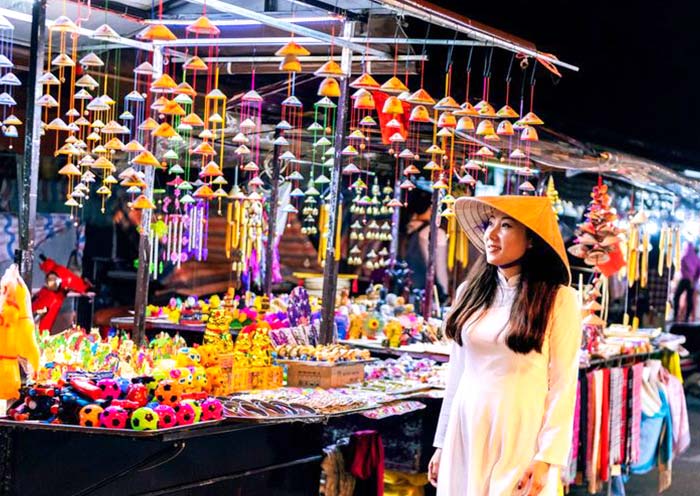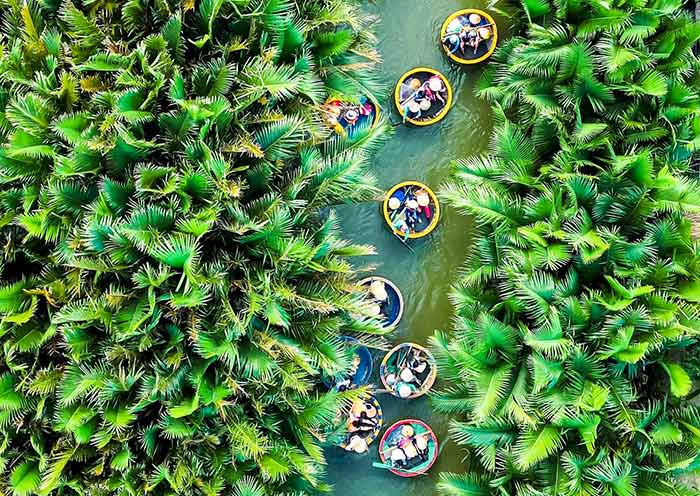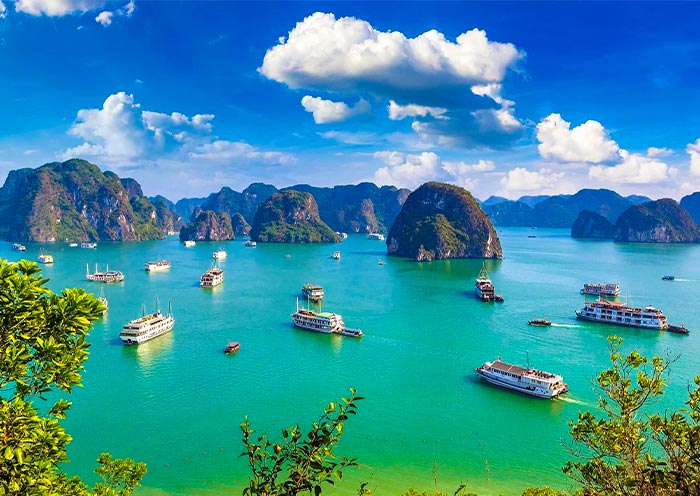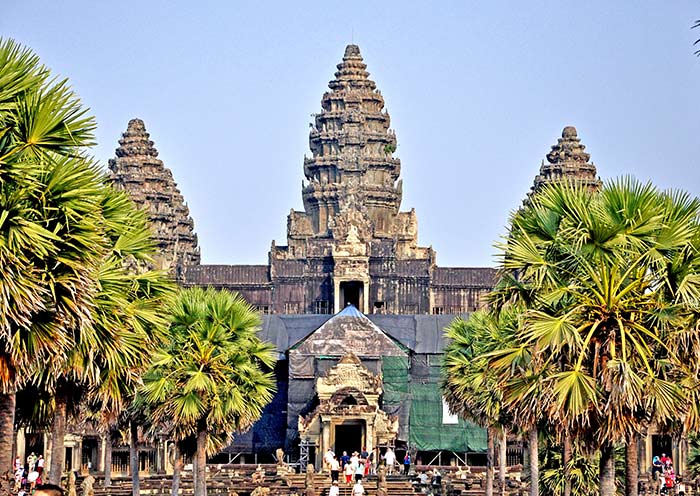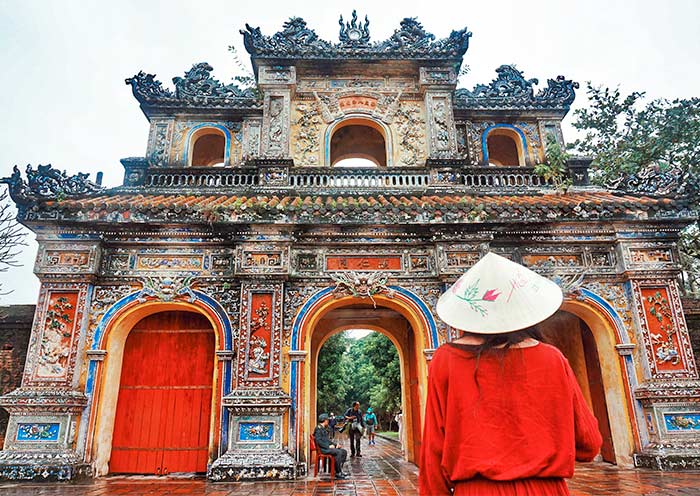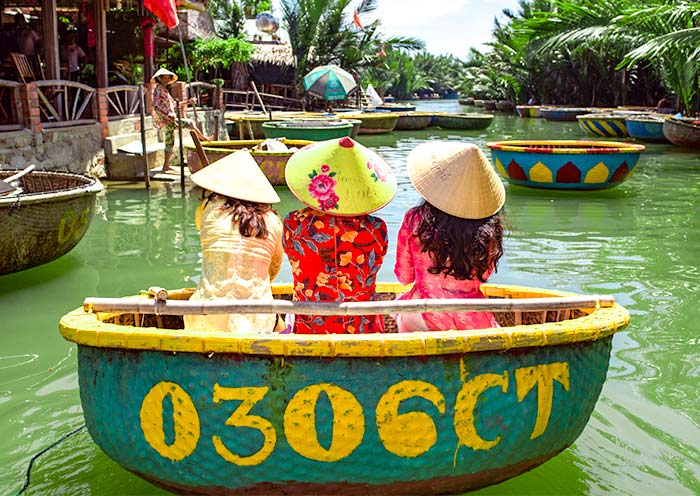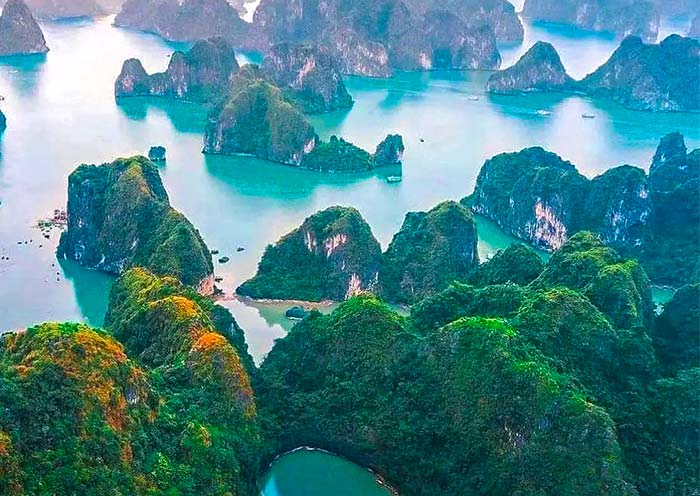We traveled with 7 lady friends. Our trip with Asia Odyssey Travel was so well planned, and seamless. Our time in Bhutan was exceptional, being led by Ugyan and Doji. What two very wonderful men. They were both so very knowledgeable, kind, and helpful. I cannot say enough good about our time in Bhutan with these two good men,...our guide and driver. Thank you Asia OdysseyTravel!!! p.s. Our trip was planned by Tony of Asia Odyssey. He was amazingly helpful, and planned our trip flawlessly! Thank you, Tony!
11 Days Cultural Cambodia and Vietnam Tour: Ancient Temples, Towns, Heritages
- Highlights
- Itinerary
- Price
- Trip Notes
- Accommodation
- Photos
- Reviews
From Temples to Traditions: A Cultural Exploration of Cambodia and Vietnam
Whether you're a history buff, a cultural enthusiast, or just looking to explore some of Southeast Asia's most fascinating sites, this 11-day cultural tour through Cambodia and Vietnam is an unforgettable journey through time and tradition that is not to be missed.
In Cambodia, you'll feel transported back in time as you traverse the ruins of Angkor Wat and Angkor Thom, the ancient centers of the Khmer civilization in Siem Reap.
Vietnam presents a tapestry of historical narratives across different eras. In Ho Chi Minh City (formerly Saigon), explore a city that tells the story of the Vietnam War and colonial past through its museums, palaces, and architecture.
In Hoi An, the well-preserved town reveals a blend of indigenous and foreign influences in its architecture and urban design, with vibrant lantern-lit streets and traditional shops hinting at its past as a thriving port. Hue, the former imperial capital of the Nguyen dynasty, offers a glimpse into Vietnam's feudal culture and political history through its Imperial City and the Mausoleums of Emperors like Khai Dinh.
A tour in Hanoi reveals the evolution of Vietnam's capital over the centuries. The addition of experiences like the Halong Bay Cruise, the Mekong Delta boat trip, and the Cam Thanh Coconut Basket Boat Trip injects an element of excitement and adventure into the journey. Join us, experience a journey that is as educational as it is enlightening, and as fun as it is fascinating!
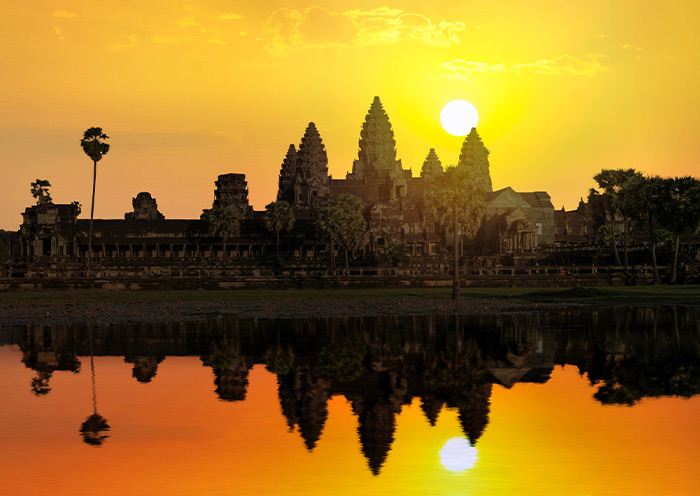
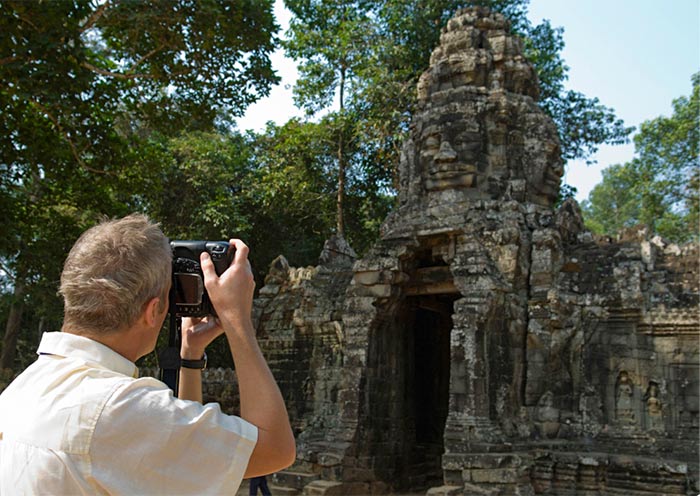
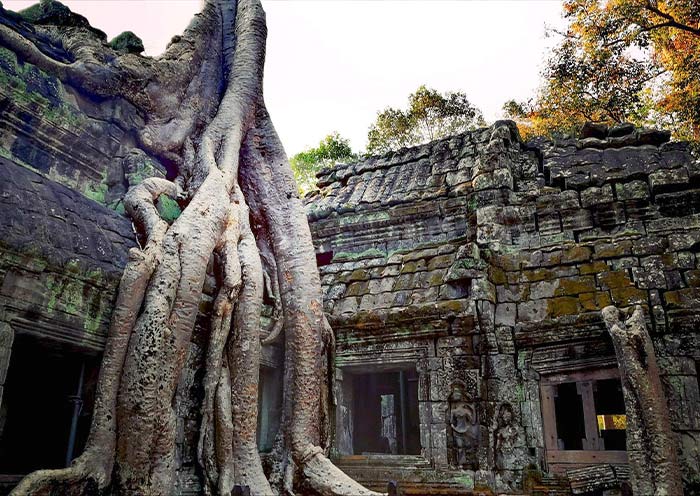
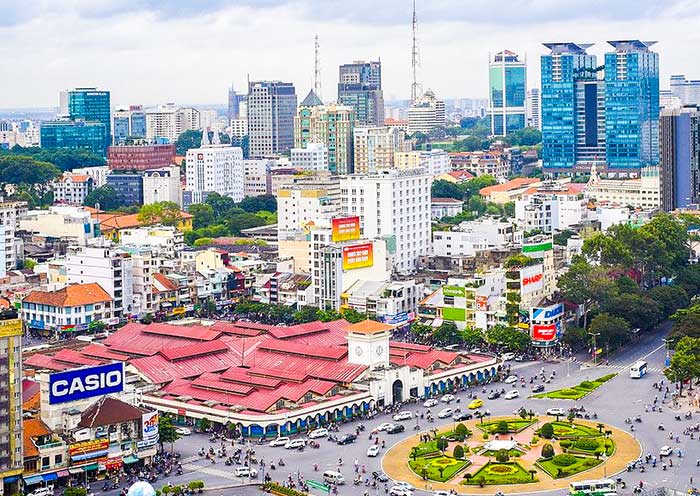
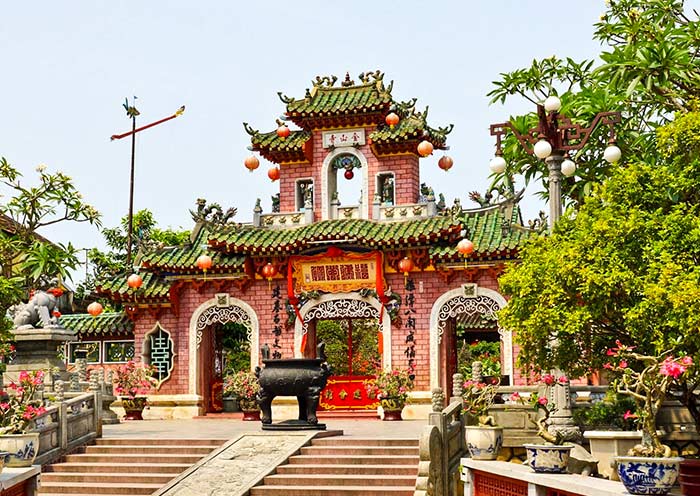
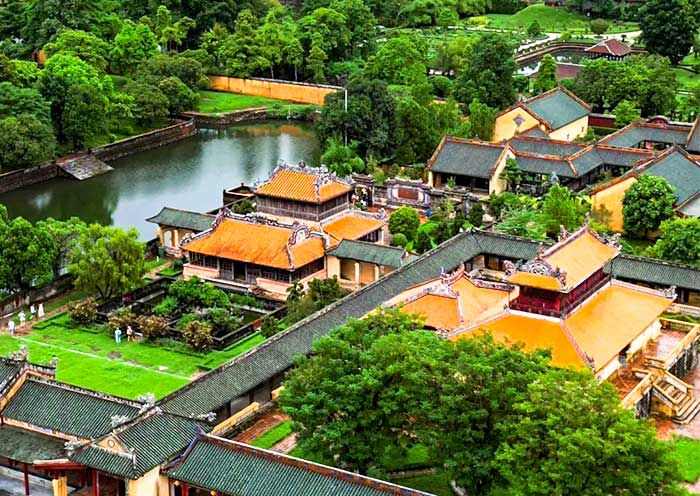
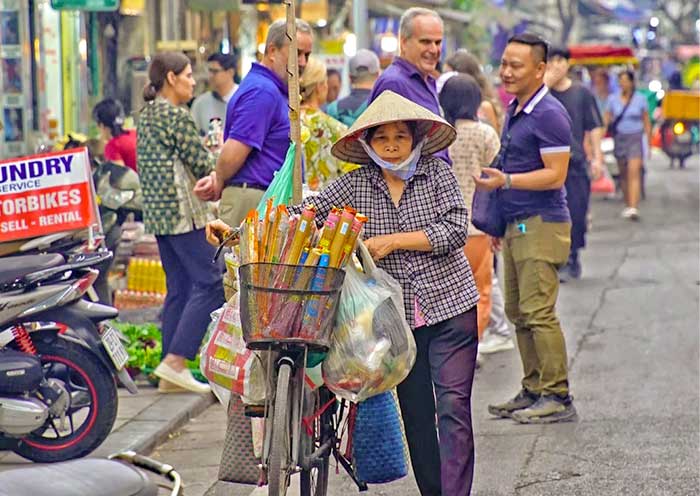
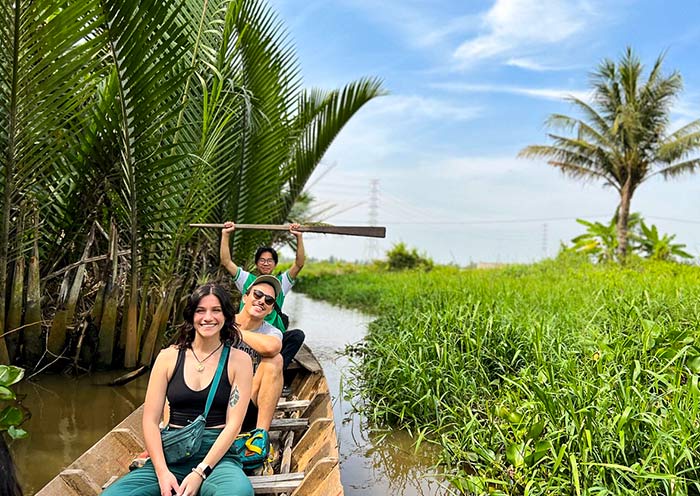
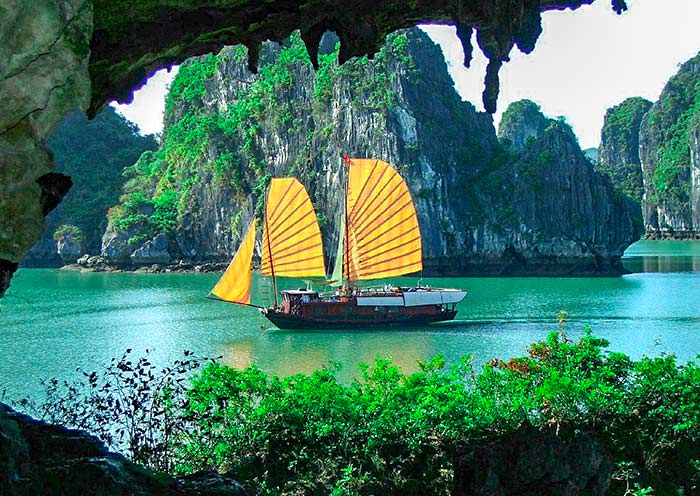
Itinerary at a Glance
Siem Reap ( 2.5 Days)
Angkor Wat & Sunrise, Ta Prohm, Angkor Thom, Phnom Bakheng & Sunset, Floating Village, Tonle Sap Lake
Ho Chi Minh City (1.5 Days)
War Remnants Museum, Reunification Palace, Central Post Office, Nha Tho Tan Dinh, Ben Thanh Market.
Mekong Delta (1 Day)
Vinh Trang Pagoda, My Tho boat trip, Ben Tre boat trip & cycling tour
Da Nang (0.5 Day)
Fly to Da Nang from Ho Chi Minh City
Hoi An (1 Day)
Hoi An Ancient Town, Cam Thanh coconut basket boat trip
Hue (1 Day)
Hai Van Pass Tunnel, Hue Imperial City, Mausoleum of Emperor Khai Dinh, Thien Mu Pagoda, Dong Ba Market
Hanoi (2 Days)
Tran Quoc Pagoda, Ho Chi Minh Mausoleum, One Pillar Pagoda, Temple of Literature, Vietnam National Museum of History, Hoan Kiem Lake, cyclo tour to old quarter, Water Puppet Show (Optional)
Halong Bay (1.5 Days)
Halong Bay, Halong Bay Cruise, Visit Sung Sot Cave, Titop Island, Trinh Nu Cave
Hanoi
Airport see-off
Itinerary Day by Day
Welcome to Siem Reap, your gateway for the Temples of Angkor. When you arrive at Siem Reap–Angkor International Airport (SAI), your tour guide and driver will meet you at the exit and then escort you to the hotel in downtown Siem Reap.
Siem Reap is a city in northwestern Cambodia, best known as the gateway to the Temples of Angkor, including the iconic Angkor Wat, which is just 6 kilometers away. The city has transformed into a major tourist hub, with a diverse range of accommodations, and bustling nightlife with numerous restaurants, bars, and night markets.
In the evening, you will enjoy a sumptuous welcome dinner buffet. While dining, you'll be treated to a captivating Khmer traditional dance performance, featuring elegant movements and vibrant costumes set to melodious traditional music.
Arrival Ideas:
Siem Reap Airport: Siem Reap-Angkor International Airport (REP) is the main airport in Siem Reap, located about 45 kilometers from downtown and approximately 50 kilometers from the Temples of Angkor.
Flights to Siem Reap: For internal flights, the most common routes are from Phnom Penh, the capital of Cambodia, and occasionally from Sihanoukville, especially during the tourist season. For international flights, it is well connected with major cities in Asia, making it relatively easy to find direct flights from places like Bangkok, Kuala Lumpur, Singapore, Ho Chi Minh City, and various cities in China.

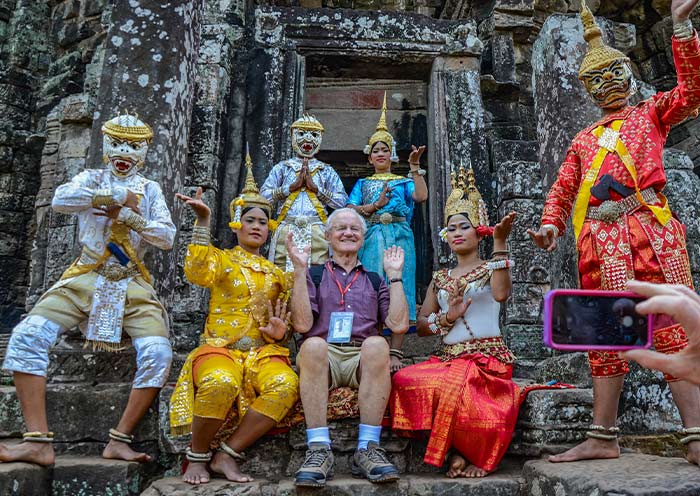
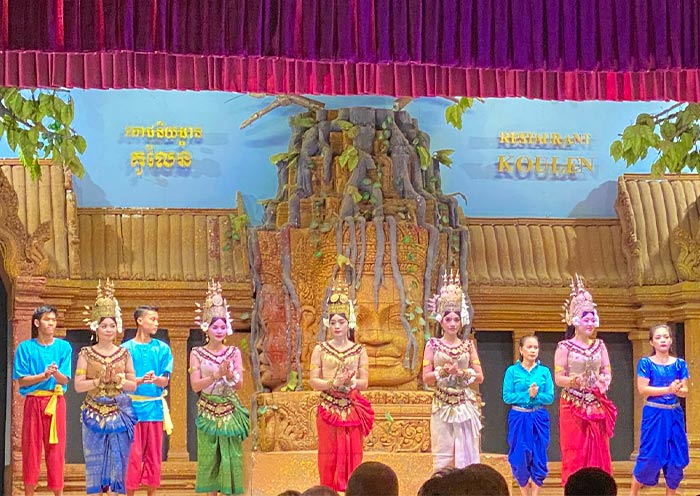
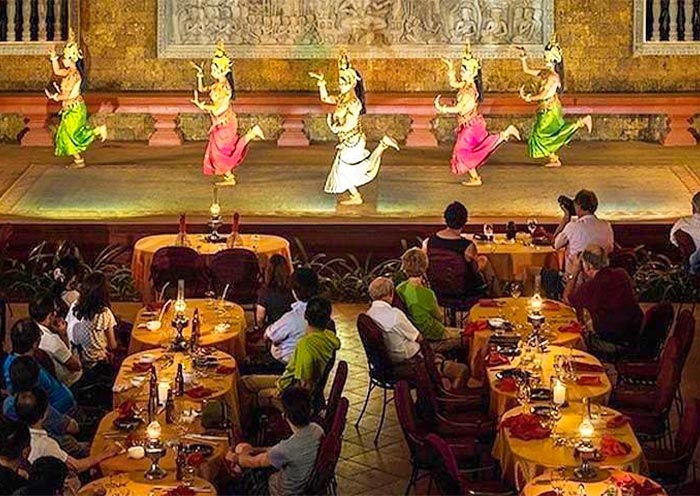
Designated as a UNESCO World Heritage site, Angkor Archaeological Park is a vast and impressive complex. It spans an area of roughly 400 square kilometers and contains the magnificent remains of the various capitals of the Khmer Empire, which flourished from the 9th to the 15th centuries.
Today, we will guide you through an exploration of some of the most iconic temples and structures within the park, including the majestic Angkor Wat and Angkor Thom complexes, and the enchanting Ta Prohm.
Scenic Spots You will Pass:
Sunrise → Angkor Thom → Ta Prohm → Angkor Wat → Phnom Bakheng Sunset → Get back to your Hotel
Start your day early with a sunrise viewing at Angkor Wat. Arrive at Angkor Wat in time to find a good spot to watch the sunrise. Tips: The sun rises between 5:30 AM and 6:30 AM, depending on the time of year. The silhouette of Angkor Wat’s iconic spires stands sharply against the lightening backdrop, creating a stunning contrast that slowly fills with color. The temple's vast moat reflects this magical scene, doubling the beauty in a perfect mirror image that enhances the surreal atmosphere. After the sunrise, head back to your hotel for breakfast and a short rest.
After breakfast, head to Angkor Thom, the last and most enduring capital city of the Khmer empire. It was established in the late 12th century by King Jayavarman VII in the late twelfth century. Angkor Thom means "Great City" in Khmer. Set over 10 square kilometers, the aptly named last great capital of the Khmer empire took monumental to a whole new level.
Enter through the South Gate and proceed to the Bayon Temple at the city's center. This temple is known for its numerous smiling faces carved into its towers. Each of its 54 Gothic towers is decorated with 216 gargantuan smiling faces of Avalokiteshvara. The temple also features 1.2km of extraordinary bas-reliefs, incorporating more than 11,000 figures. Take your time to marvel at these detailed bas-reliefs, which portray historical events and scenes from daily life in the empire. A short walk northwest from the Bayon will bring you to the Baphuon Temple. This temple, which predates Angkor Thom, was originally a Hindu temple dedicated to Shiva.
Next, visit the Terrace of the Elephants. King Jayavarman VII used this terrace as a viewing platform to observe his victorious returning army. You'll find it adorned with carvings of elephants and other animals, providing excellent photo opportunities. Continue to the nearby Terrace of the Leper King. This 7-meter high laterite platform features multiple tiers of meticulously carved walls depicting nagas (serpents), demons, and various mythical beings. Conclude your visit to Angkor Thom by exiting through the Victory Gate on the east side of the city.
Later, proceed to Ta Prohm (Jungle Temple). Its appeal lies in the fact that, unlike the other monuments of Angkor, it has been swallowed by the jungle, and looks very much the way most of the monuments of Angkor appeared when European explorers first stumbled upon them. It was also featured in the movies "Tomb Raider" and “Raiders of the Lost Ark”, which adds to its popularity. After exploring Ta Prohm, enjoy a relaxing lunch at one of the local restaurants nearby.
In the afternoon, return to Angkor Wat for a more detailed tour of this iconic temple. Uniquely designed with a westward orientation, Angkor Wat is best viewed in the afternoon light. Angkor Wat, the largest monument of the Angkor group and the best preserved, is an architectural masterpiece. Its perfection in composition, balance, proportions, relief, and sculpture make it one of the finest monuments in the world.
Angkor Wat is surrounded by a vast moat, 190 meters wide, forming a rectangle of 1.5 by 1.3 kilometers, which symbolizes the mythical oceans surrounding Mount Meru, the center of the universe in Hindu cosmology. Visitors can enter through the west-facing main gate, which leads directly into a long causeway lined with naga balustrades. Spend time in the galleries which feature extensive bas-reliefs depicting epic stories such as the Battle of Kurukshetra from the Mahabharata, the Judgment by Yama, the Hindu god of death, and scenes of heavenly nymphs (Apsaras) and everyday life in the Khmer Empire. At the heart of the temple complex is the central sanctuary surrounded by four smaller towers, forming a quincunx. The central sanctuary, rising majestically above the forested landscape, symbolizes the mythical Mount Meru and offers a unique perspective on the temple’s layout and the geometric precision with which it was built. Climb up to the central tower, a privilege that offers not only a closer view of the intricate lintel carvings and sculpted friezes but also panoramic views of the entire complex and its surroundings.
If you have enough energy, consider climbing up to Phnom Bakheng Hill to enjoy the sunset view. The climb takes about 15-20 minutes. Arrive early as this popular spot can get crowded at sunset. From here, watch the sky change colors over the main temples of Angkor and the surrounding forests - a perfect end to a day of exploration.
After the tour, drive back to your hotel. Stay overnight in Siem Reap.
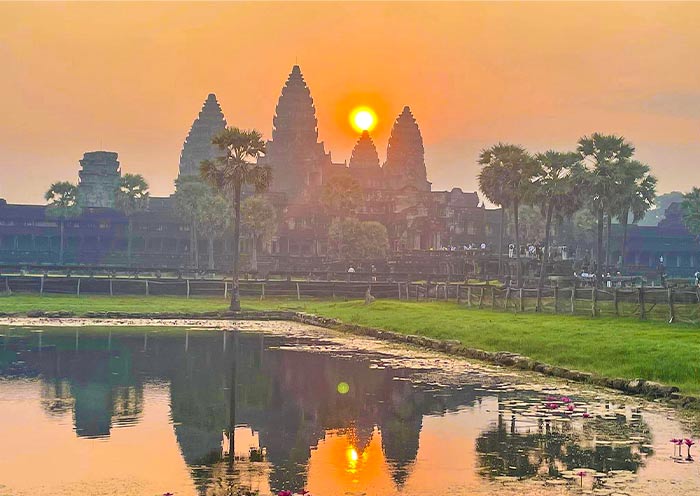
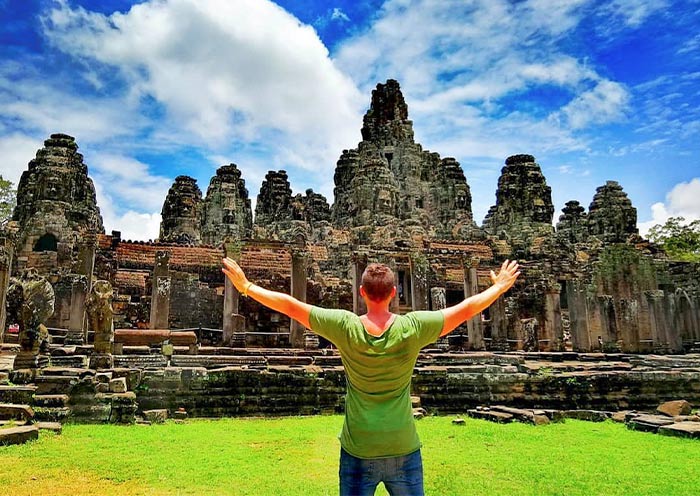
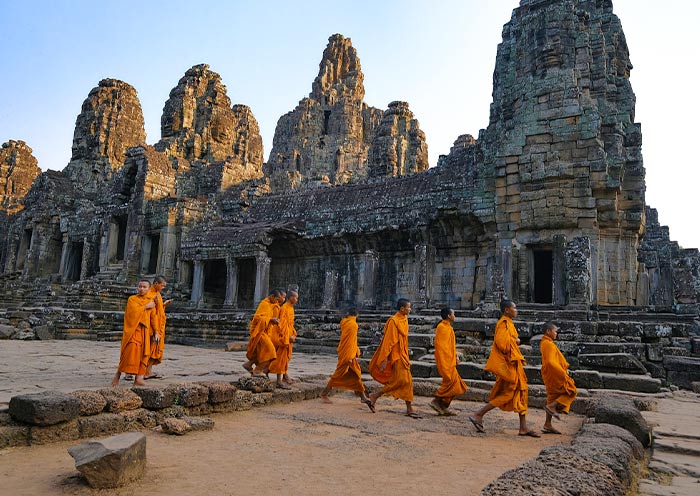

After breakfast, you will travel to Tonle Sap Lake to visit the floating village of Kompong Khleang. Known as the largest freshwater lake in Southeast Asia, Tonle Sap is home to numerous floating villages. These are unique for their stilted houses, which are built on platforms supported by wooden poles or tethered to boats, adjusting to the lake's changing water levels. The villages also have floating schools, shops, and even churches. Enjoy a boat ride (about 1.5 hours) to observe the residents' unique lifestyle and the region's rich biodiversity.
Then, you'll driven to Siem Reap–Angkor International Airport for your departure. The drive takes approximately an hour.
Welcome to Ho Chi Minh City! Formerly known as Saigon, Ho Chi Minh City is the largest city in Vietnam. Located in southern Vietnam, it's a well-blended mix of historical significance and modern dynamism.
Upon arrival at Tan Son Nhat International Airport in Ho Chi Minh City (approximately 6.5km from downtown), your local guide will meet you and escort you to your hotel. The rest of today is free for you to explore the city on your own.
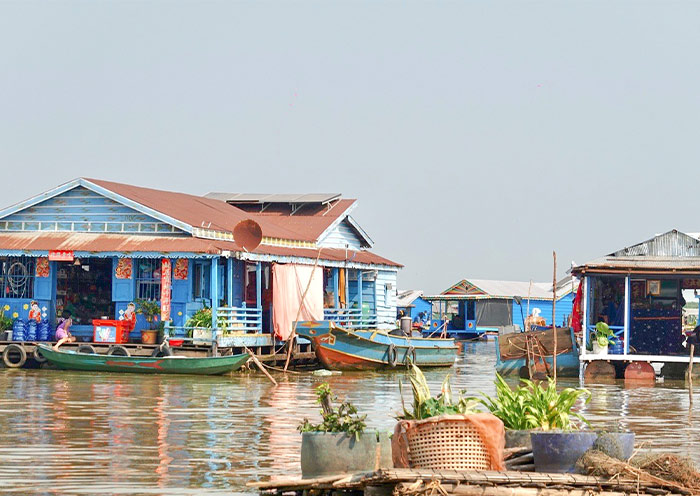
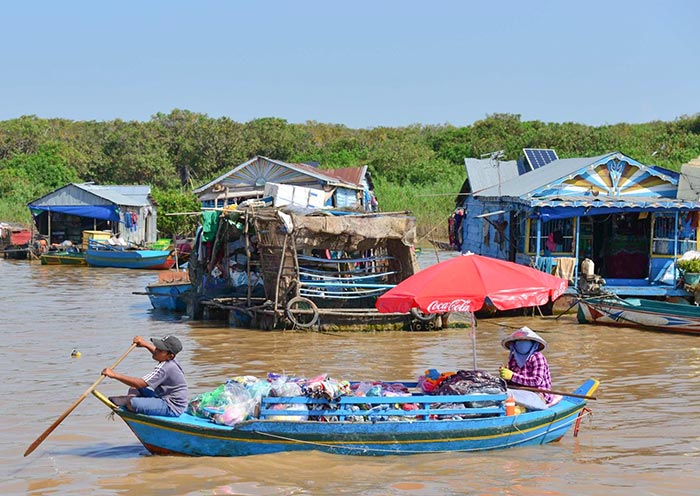

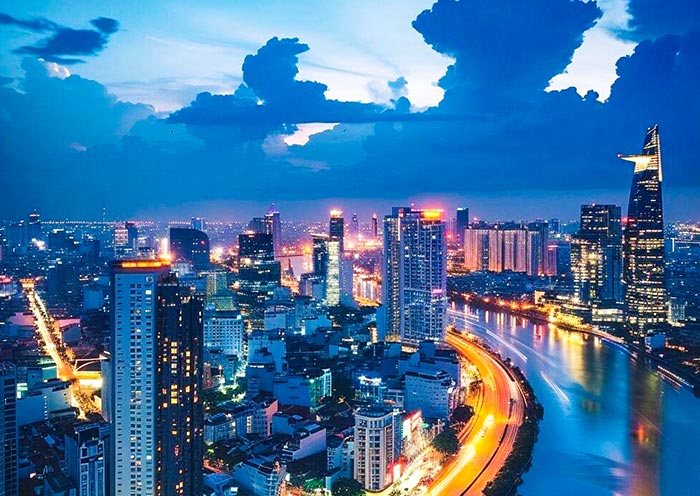
After breakfast, spend a full day exploring the Mekong Delta at a relaxing pace. Mekong Delta, located in southwestern Vietnam, is a vast maze of rivers, canals, islands, and rice paddies formed by the Mekong River as it empties into the sea. Known as the "rice bowl" of Vietnam, the Delta is a major agricultural hub, producing a significant portion of the country's rice and fish.
Start from Ho Chi Minh City, you will pass through green rice fields and small villages to arrive in beautiful rural My Tho. Upon arrival, your first stop is Vinh Trang Pagoda. Built in the mid-19th century, Vinh Trang is renowned for its stunning architecture, showcasing a harmonious fusion of Vietnamese, Chinese, and Khmer influences. You will be amazed by the outstanding architecture, meticulously carved columns with intricate details, and visits to the Statue of Maitreya Buddha, Statue of Amitabha Buddha, Reclining Buddha statue, and 7-story tower.
Later, head to the nearby pier to board a traditional Mekong Delta boat for a scenic cruise along the majestic river. As you explore, lush greenery and bustling river life will captivate you. Glide past the Turtle, Dragon, and Phoenix Islets, eventually arriving at the enchanting Unicorn Islet. And, delve deeper into the Delta's heart with a ride on a traditional sampan boat through narrow waterways lined with coconut palms. This intimate experience allows you to appreciate the unique ecosystem and the local way of life firsthand. Stop at a bee farm to savor honey tea, taste local fruits, and immerse yourself in traditional music performed by the villagers. Learn about their daily lives and gain a deeper understanding of the region's culture. Enjoy a local lunch with Vietnamese dishes.
After lunch, take a boat trip to Ben Tre, known as the coconut kingdom, a charming town famous for its coconut plantations and fruit orchards. Enjoy a leisurely bike ride through the countryside and learn about how coconut products are produced in the region. Visit a coconut candy workshop.
After the memorable tour, get back to Ho Chi Minh City.
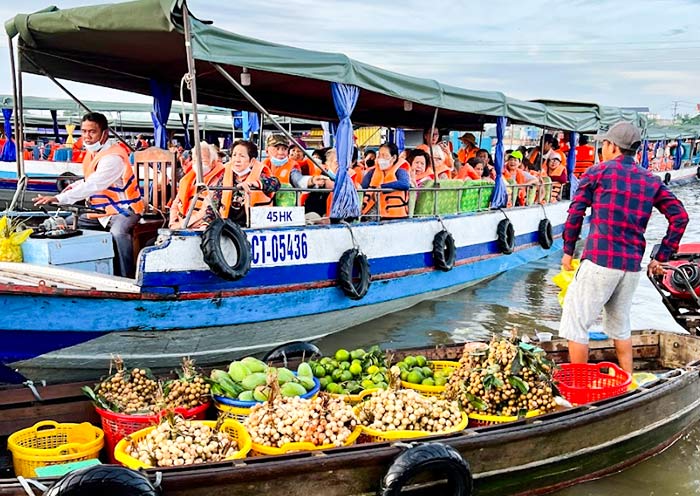

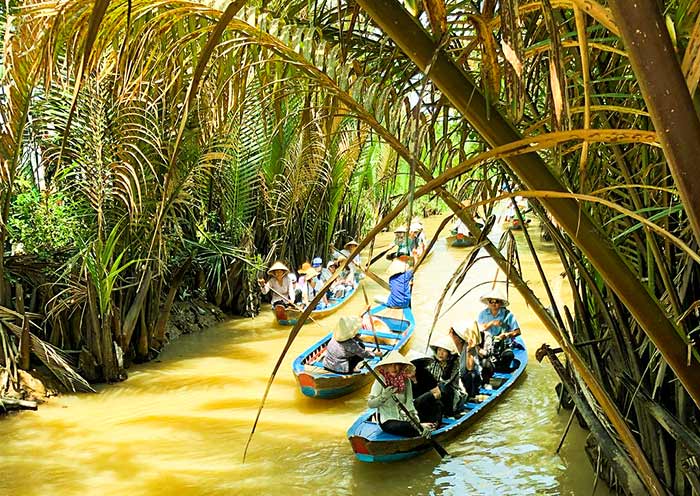
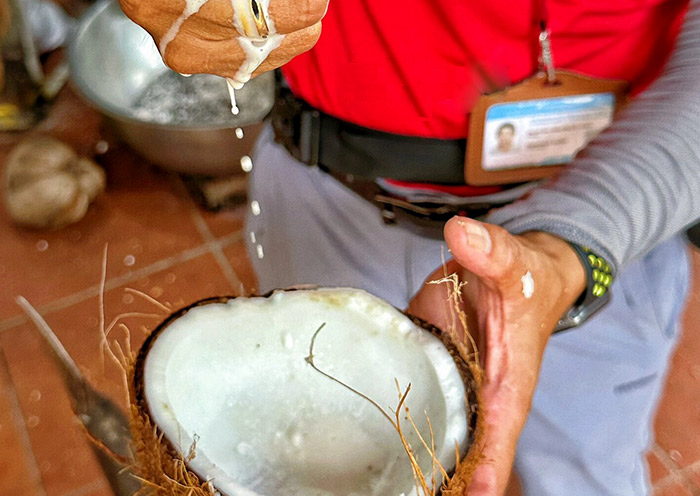
Today, your first stop is the Reunification Palace, also called the Independence Palace, a captivating architectural marvel that once served as the residence of the South Vietnamese President. Here, you can witness the iconic image of North Vietnamese tanks storming the palace gates, a defining moment that marked the end of the Vietnam War in 1975. Next, we head to the War Remnants Museum, a poignant and powerful testament to the realities of the Vietnam War. Prepare to be moved by exhibits showcasing artifacts, photographs, and weaponry that tell stories of war and resilience.
Next on your itinerary is Nha Tho Tan Dinh, also known as the Pink Church. This vibrant landmark stands out with its unique hue, making it instantly recognizable and a popular spot to capture stunning photos. Step back in time as you learn that Nha Tho Tan Dinh was built in the late 19th century, making it one of the oldest churches in Ho Chi Minh City. Admire the fascinating blend of Romanesque and Gothic styles in its architecture, with two grand bell towers flanking the entrance. Snap some cool pictures outside to remember your visit!
Then, be transported back in time at the Central Post Office, a majestic building constructed in the early 20th century. Take a moment to appreciate the impressive facade with its wrought-iron details and colorful mosaic floors. (Optional Experience: To create a lasting memory of Vietnam, send postcards to your loved ones from this historic landmark.)
Later, experience Saigon's famed coffee culture by visiting the Coffee Apartment, and culminate your exciting day with a captivating immersion into the vibrant atmosphere of Ben Thanh Market. Explore a world of local crafts, and don't miss the chance to tantalize your taste buds with the incredible array of Vietnamese street food - a sensory explosion not to be missed!
After tour, you'll be transferred to Tan Son Nhat International Airport for your flight to Da Nang (approximately 1h and 25m).
Upon arrival in Da Nang, you'll be met by your tour guide and whisked away for a scenic 1-hour drive to Hoi An. Welcome to Hoi An, a UNESCO World Heritage Site famed for its enchanting Hoi An Ancient Town! This charming town boasts a unique blend of architectural styles, reflecting Vietnamese, Chinese, Japanese, and European influences. Your guide will then take you to your hotel in Hoi An for check-in.
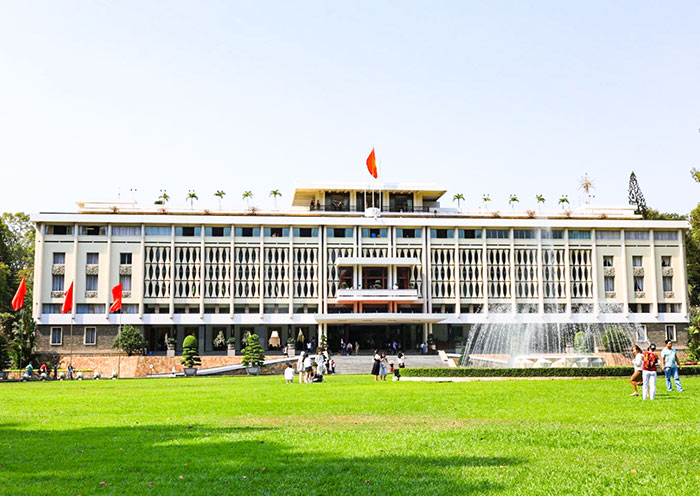

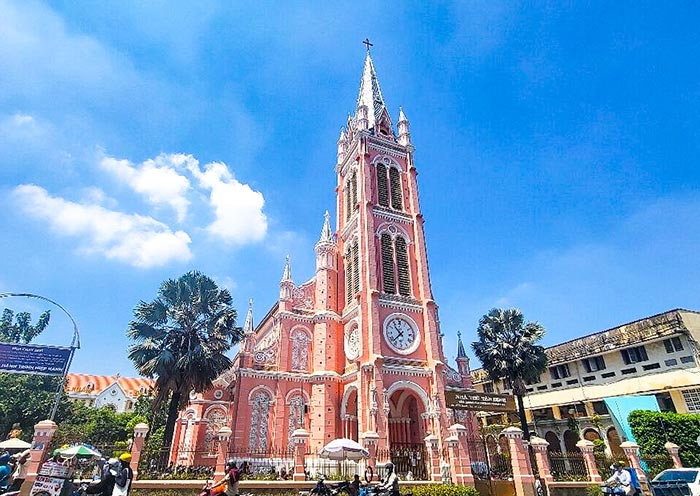

After breakfast, your tour guide will pick you up at your hotel for a half-day excursion to Cam Thanh village, a charming fishing village nestled amidst the Cam Thanh Water Coconut Forest.
The basket boat's history can be traced back over 2,000 years to the Cham people who settled in this area. Originally designed for fishing in shallow waters, these unique Vietnamese watercraft are still used today.
Upon arrival, prepare to take an exciting 45-minute to 1-hour adventure on a traditional basket boat. Crafted from bamboo and woven palm leaves, these boats will take you on a journey through the heart of the verdant coconut palm forest. As you glide through the serene waterways, surrounded by lush coconut groves and vibrant rice paddies, soak in the peaceful atmosphere. Witness the unique ecosystem teeming with diverse flora and fauna. Learn about the local community's commendable efforts in preserving this remarkable environment.
Other activities and experiences include:
- Dance with the locals in the basket boat;
- Try your hand at casting traditional nets and basket traps;
- Catch crabs or snails by the riverbank.
Optional Activities after Basket Boat Trip:
Immerse Yourself in Culinary Delights: After the basket boat trip, why not take a fascinating cooking class? A skilled chef will guide you through the intricacies of Vietnamese cuisine, explaining the unique ingredients and traditional cooking methods. By the course's end, you'll be equipped with recipes to recreate these delicious dishes for your family and friends back home. Expect to learn about 4 courses during this hands-on experience.
After your exciting excursion to Cam Thanh village, you'll return to Hoi An where you can savor a delicious lunch of authentic Vietnamese cuisine. This afternoon, enjoy a captivating exploration of Hoi An Ancient Town with your knowledgeable guide.
Hoi An Ancient Town, a UNESCO World Heritage Site, is an exceptionally well-preserved example of a Southeast Asian trading port dating from the 15th to the 19th centuries. The complex boasts 1,107 timber-frame buildings. It represents a fusion of indigenous and foreign cultures (principally Chinese and Japanese, with later European influences) that combined to produce this unique, well-preserved town. Walking through Hoi An is like stepping back in time. Our guide will lead you to some of the town's most significant landmarks, including the iconic Japanese Covered Bridge, the ornate Fujian Assembly Hall, and the historic Tan Ky House (Old House of Tan Ky). After, explore the bustling Hoi An market and delve into some of the delicious local offerings, like Cao Lau (Pork Rice Noodles), Com Ga (Chicken Rice), Banh Mi (Vietnamese Baguette), White Rose Dumplings (Banh Bao Vac), and Mi Quang (Turmeric Noodle Soup).
After the tour, you’ll be transferred back to the hotel, and then you can have the rest of the day to yourself.
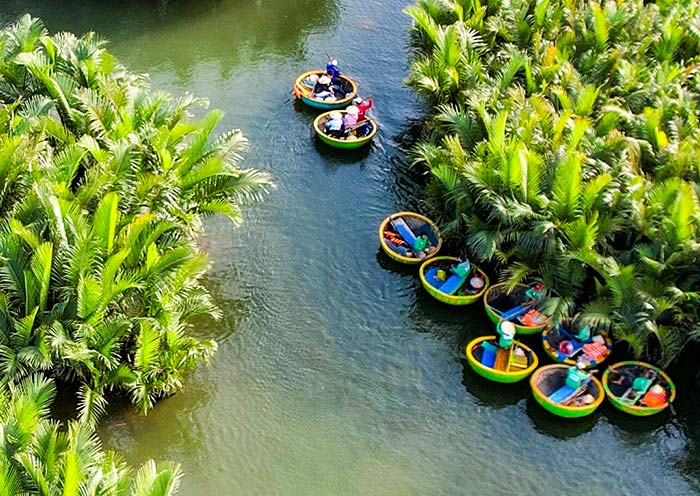



After breakfast, your guide and driver will pick you up at your hotel in Hoi An and whisk you away to Hue City. The 121km journey takes about 2.5-3 hours. Along the way, you'll drive through the Hai Van Pass Tunnel, which held the title of Southeast Asia's longest tunnel upon completion. On the Da Nang side, prepare to be dazzled by lush coastal mountains, the sparkling East Sea, and the vibrant cityscape of Da Nang. In contrast, the Hue side offers a serene landscape of rolling hills, rural countryside, and glimpses of the Perfume River.
For those who crave the scenic beauty of Hai Van Pass, a viewpoint awaits near the tunnel entrance on the Da Nang side. This vantage point allows you to admire breathtaking vistas of the mountains, the coast, and the winding road snaking below. Descending from the pass, you might catch a glimpse of Lang Co Beach, a beautiful stretch of pristine sand fringed with coconut palms.
Upon arrival, you'll be greeted by the Mausoleum of Emperor Khai Dinh, perched regally on a slope of Chau Chu Mountain. Built as the final resting place for Emperor Khai Dinh, the twelfth ruler of the Nguyen Dynasty (1916-1925), the mausoleum is renowned for its unique architectural blend. Here, traditional Vietnamese elements are masterfully fused with French-influenced details, creating a visually striking landmark distinct from other imperial tombs in the area. As you enter, prepare to be dazzled by the elaborate decorations and intricate designs. The walls are adorned with colorful mosaics meticulously crafted from ceramic fragments, offering a visually captivating experience. Look up to admire the ceilings, adorned with intricate paintings and carvings that showcase the fine craftsmanship of the artisans who built this remarkable structure.
After lunch, the main highlight is Hue Imperial City, also known as the Citadel. This former seat of power for the Nguyen Dynasty, Vietnam's last ruling dynasty, flourished as the country's political, administrative, and cultural center for over a century. Exploring the Citadel allows visitors to delve into Vietnam's imperial past and gain insights into its rich history. Modeled after the Forbidden City in Beijing, the Hue Imperial City is about half the size of its counterpart.
Enter through Ngo Mon Gate, a symbolic entrance adorned with vibrant colors. It is an imposing structure with two levels and a central passageway reserved for the emperor. Begin your exploration by following the counter-clockwise direction. Following the route, proceed to Thai Hoa Palace, the Hall of Supreme Harmony. This impressive structure served as the throne room for important ceremonies and royal receptions. Pass through Halls of the Mandarins, Thai Binh Lau (Emperor’s Reading Room), Duyen Thi Duong (Royal Theater), Co Hua Gardens, Forbidden Purple City (private residence for the Nguyen emperors), Dien Tho Residence (place for the concubines), etc.
After exploring the Imperial City, head to Thien Mu Pagoda, a captivating landmark gracing the banks of the Perfume River in Hue. As one of the oldest and most revered pagodas in the city, it boasts a unique seven-story octagonal tower, the tallest of its kind in Vietnam. Each level is adorned with intricate Buddhist symbols and offers beautiful vistas of the surrounding landscape.
Last, let's go to Dong Ba Market, a bustling hub in Hue's heart. As one of the oldest markets in the city, it offers a wide variety of goods, from traditional clothing and food to souvenirs and jewelry. Browse the daily fresh ingredients used in Central Vietnamese cooking, a plethora of delectable local specialties, and exquisite handicrafts, all under one roof.
Optional Experience with Sunset Cruise along Perfume River:
Glide down the Perfume River on a traditional wooden dragon boat cruise and discover the magic of Hue in the late afternoon. Relax and soak in the fresh air as you pass by beautiful garden houses, ancient pagodas, and witness a romantic sunset painting the sky over the river.
Stay overnight in Hue.
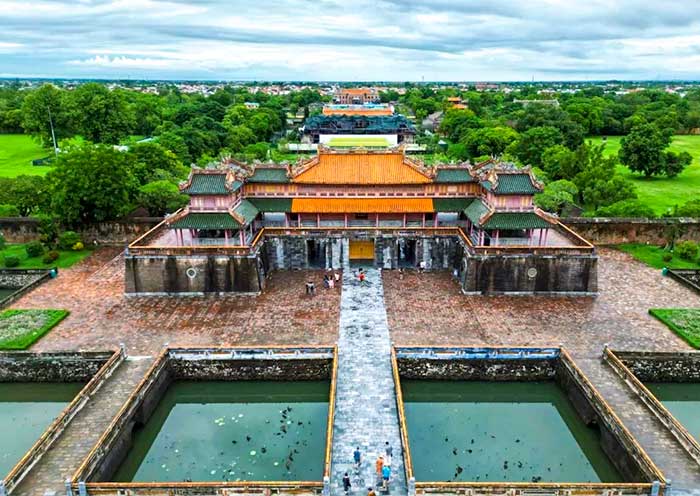



This morning, you'll be transferred to Hue Phu Bai International Airport for your flight to Hanoi (approximately 1h and 15m). Welcome to Hanoi, the capital city of Vietnam! Upon arrival at Noi Bai International Airport, you will be met by our local guide and driver. Then, we will take you to your carefully selected hotel in Hanoi. We will assist you with check-in. The rest of today is free for you to explore this old and charming city at your own pace.
Hanoi, located in northern Vietnam, boasts a rich history dating back over 1,000 years. It showcases a blend of Vietnamese, Chinese, and French influences. Renowned for its diverse culinary scene, Hanoi is considered a food lover's paradise to taste Vietnamese cuisine. The city is famous for its street food, where you can savor an array of local specialties.
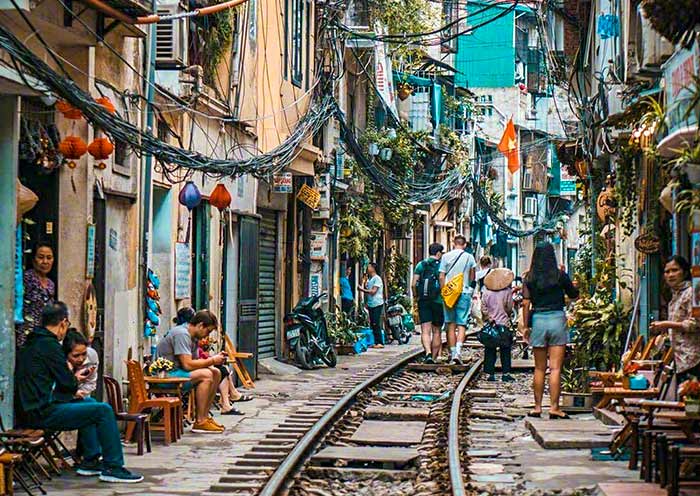
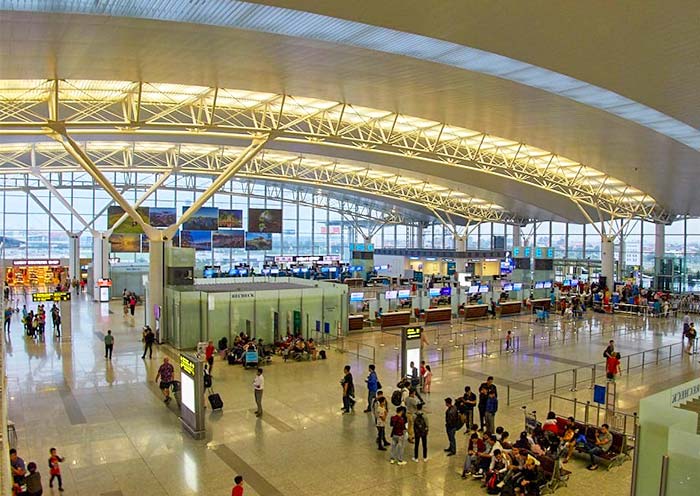
After breakfast, your guide will pick you up at your hotel for a delightful day exploring Hanoi City. This city holds a unique charm despite not being the most modern. Its character lies in the captivating blend of Vietnamese, Chinese, and French influences, all woven together with the city's authentic and bustling local life within its old alleyways. Indulge in the delicious local street food for a taste of true Vietnamese flavors.
Our first stop is a tranquil escape to Tran Quoc Pagoda, nestled amidst the picturesque West Lake. It is the oldest Buddhist temple in Hanoi, with a history dating back over 1500 years. As you approach, you'll be greeted by the sight of the iconic 11-story lotus tower, a symbol of the pagoda. Step inside the main hall and explore its beauty, where intricate carvings and frescoes adorn the walls. Be sure to admire the serene lotus pond, adding to the pagoda's peaceful atmosphere.
Later, head to the Ho Chi Minh Mausoleum, situated in Ba Dinh Square. The mausoleum serves as the final resting place of Ho Chi Minh (Uncle Ho), the revered leader of Vietnamese independence and the founding father of modern Vietnam. Dress respectfully and visit the mausoleum to pay homage to this iconic figure and learn about his immense role in shaping the nation. If you're lucky, you might witness the solemn and precise military honor guard ceremony. (Note: 1. The Mausoleum closes from Sep. 4 to Nov. 4 every year. 2. The surrounding sites include the Presidential Palace, Ho Chi Minh's Stilt House, and the Ho Chi Minh Museum.)
Afterward, enjoy a short walk to visit the One Pillar Pagoda. Prepare to be amazed by its distinctive shape: the main building sits atop a single stone pillar, resembling a lotus flower blossoming from a pond. Legend has it that Emperor Ly Thai Tong dreamt of receiving a son from the Buddhist goddess of mercy, Quan Am Bo Tat, on a lotus flower. The pagoda's construction served as a way to express his gratitude. Later, visit the Temple of Literature, Vietnam's first university and a site dedicated to Confucianism.
This afternoon, delve into Vietnam's fascinating history at the Vietnam National Museum of History. Here, you'll gain a comprehensive understanding of Vietnam's past, from prehistoric times to the 20th century, through a captivating display of artifacts. Witness ancient bronze drums, intricate ceramics, and powerful imperial regalia, each piece whispering stories of Vietnam's remarkable evolution.
Later, head to Hoan Kiem Lake, also known as Lake of the Restored Sword, a shimmering jewel in the heart of Hanoi. Take a leisurely stroll along the lake's perimeter, enjoying a view of the iconic Turtle Tower. Legend tells the tale of Emperor Le Loi returning a magical sword to a giant turtle residing in the lake, thus giving rise to the name "Lake of the Returned Sword." Afterwards, visit Ngoc Son Temple, dedicated to various Vietnamese historical figures and the revered Confucian scholar Van Xuong.
Afterward, immerse yourself in the local life of Vietnam with a unique and fun cyclo tour! For about an hour, you'll travel at a slow and leisurely pace through the iconic Old Quarter of Hanoi. A cyclo, a traditional three-wheeled bicycle taxi, will be your chariot for exploring the narrow streets. Cruise through the famed 36 Streets (each named after a specific trade) and pass by iconic landmarks like Dong Xuan Market, St. Joseph's Cathedral, and the Hanoi Opera House. This is a fantastic way to experience the Old Quarter's charming and vibrant atmosphere firsthand! Don't miss the chance to savor the delicious variety of Vietnamese street food and local dishes!
Optional Water Puppet Show: Immerse yourself in a unique Vietnamese tradition by catching a water puppet show in the late afternoon or evening! Dating back to the 11th century, these captivating performances use colorful puppets manipulated on a water stage to depict folktales and historical events. A highly-recommended venue for this experience is the Thang Long Water Puppet Theatre.
After the tour, be escorted to your hotel in Hanoi.

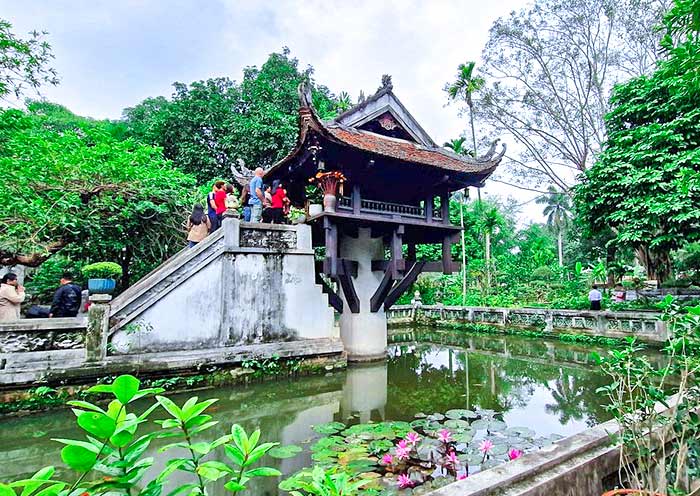
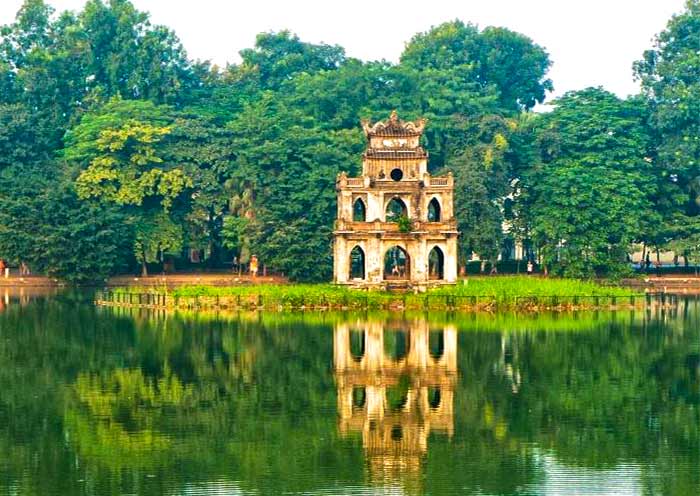

Halong Bay, A UNESCO World Heritage Site, boasts thousands of majestic limestone formations, sculpted by nature over millions of years. Reputed as “Guilin on the Sea”, these emerald islands rise dramatically from crystal-clear turquoise waters, creating a breathtaking seascape. Thanks to its dramatic cliffs, shimmering turquoise waters, and over 1,600 limestone islands and islets, Halong Bay is one of the most popular destinations in northern Vietnam. A cruise offers the best way to experience its unparalleled beauty.
Morning:
This morning, between 8:00 AM and 8:30 AM, the cruise company's shuttle bus will pick you up in Hanoi's Old Quarter area. Hop aboard and prepare to be whisked away on a scenic 2.5-hour drive (147 km) to stunning Halong Bay!
Upon arrival, you'll be warmly welcomed aboard with a refreshing drink. Following a quick safety briefing from the cruise manager, you can relax and savor a delicious lunch onboard.
Afternoon:
This afternoon, you’ll explore Halong Bay's dramatic karst landscape with your cruise! Different cruise companies offer various itineraries, but you might visit some of these fascinating spots and try water activities like kayaking, swimming, etc. Watch the sunset paint the karst mountains with colors.
- Sung Sot Cave (Surprise Cave): Discover a magnificent cave adorned with stalactites and stalagmites.
- Titop Island: Hike to the peak for breathtaking panoramic views of the bay.
- Cua Van Fishing Village: Witness the traditional way of life of local fishermen in a floating village.
- Tung Sau Pearl Farm: Learn about pearl cultivation and see these beautiful gems firsthand.
- Trinh Nu Cave (Virgin Cave): Discover a secluded cave with a unique rock formation.
Evening
This evening, indulge in a hearty dinner prepared by our talented chefs in the elegant dining room. After dinner, unwind with a variety of leisure options: join in on board games, try your hand at squid fishing, catch a night movie, or head to the bars & karaoke. Overnight onboard.
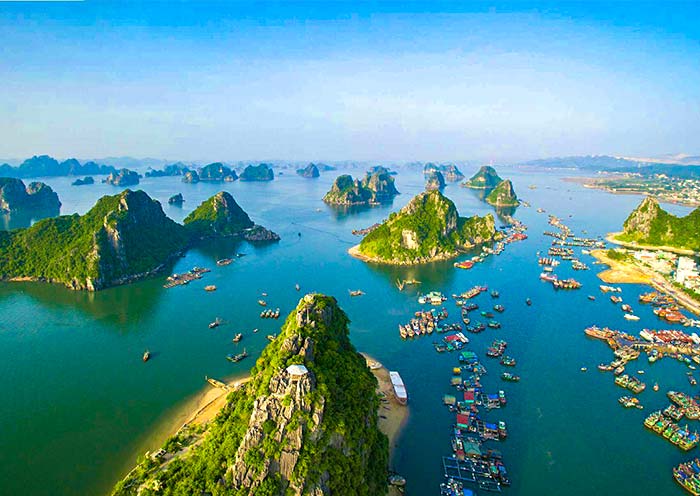
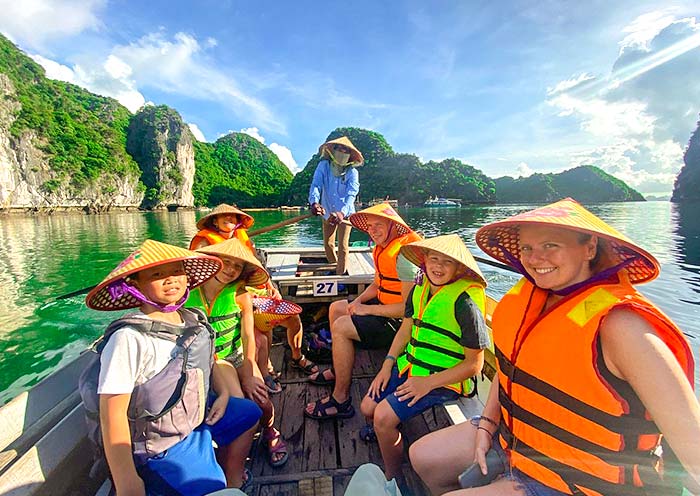
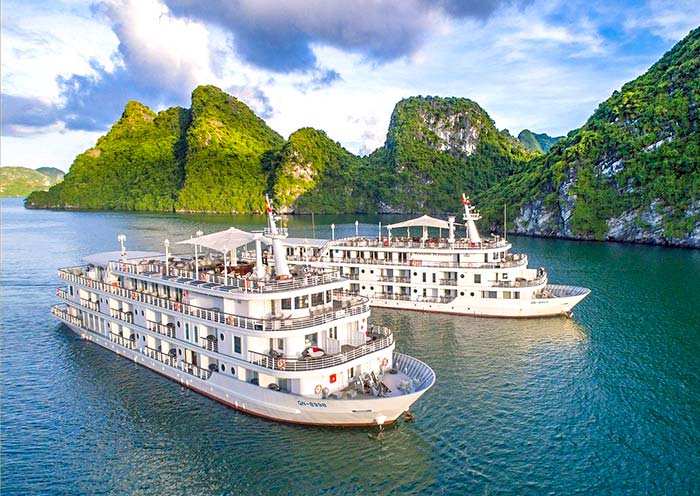
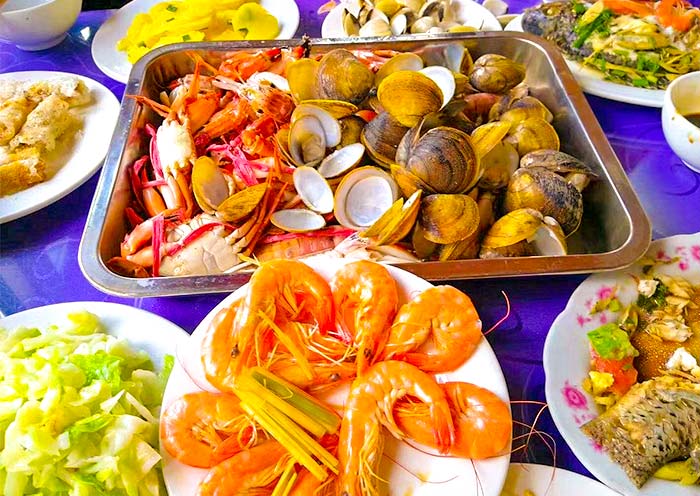
Early risers can embrace the sunrise with a Tai Chi class on the sundeck, invigorating your body and mind. Enjoy a delicious breakfast to onboard.
After breakfast, continue your exploration of Halong Bay! You can choose to participate in exciting water activities like kayaking or follow the cruise itinerary to admire the majestic limestone formations.
Later this morning, return to the cruise for a smooth check-out process at the reception. As you cruise back to the pier, savor a delightful lunch at 10:00 AM. Disembarkation will take place between 11:00 AM and 11:30 AM.
It is time to end your 11-day Cultural Cambodia and Vietnam Tour. Following disembarkation, you'll be escorted to Hanoi Noi Bai International Airport to catch a flight for your departure.
Trip Extension: If you prefer to travel longer in Southeast Asia you can extend your trip to neighboring countries such as Thailand, Vietnam, China, etc.
Thank you for choosing Asia Odyssey Travel for your Asia tour, we are always here working for you and hope to see you again for your next trip to Asia. Safe journey!
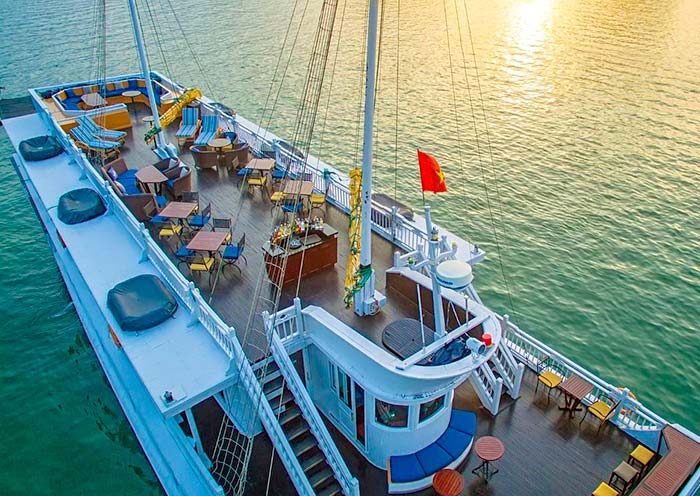
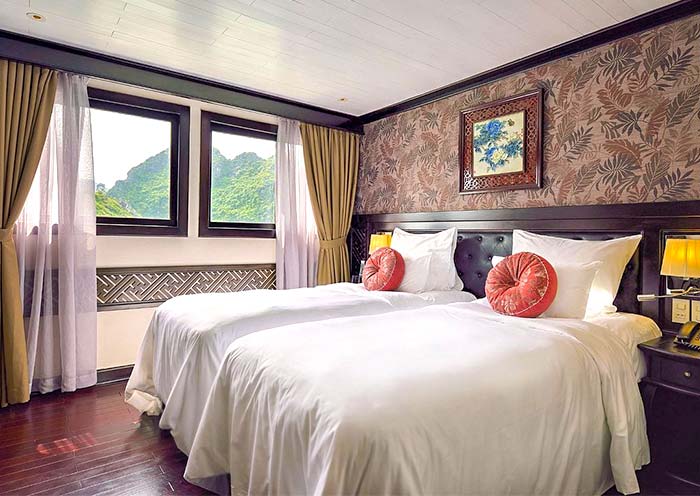
Price: What’s Included & What’s Excluded
What's Included:
What's Excluded:
Important Travel Tips for Visiting Southeast Asia
Visa requirements vary depending on your nationality and the length of your stay. It's important to check the specific requirements for each country you plan to visit well in advance of your trip. You can usually find this information on the embassy or consulate website of the country you're visiting.
Dry season (November to April): This is the peak tourist season for Southeast Asia as a whole, with the most consistent sunshine and comfortable temperatures. Ideal for beach lovers and those who want to avoid the rain. This is also a great time for trekking and other outdoor activities.
Average temperatures during Dry Season in Southeast Asia:
- Vietnam: 77°F - 86°F (25°C - 30°C): It can be slightly cooler in the northern mountains during December and January.
- Thailand: 82°F - 90°F (28°C - 32°C): Eastern and southern Thailand, including popular beach destinations, tend to be a few degrees warmer than the north.
- Laos: 75°F - 88°F (24°C - 31°C): Keep in mind that the mountainous areas of Laos can get chilly at night, especially in December and January.
- Cambodia: 84°F - 93°F (29°C - 34°C): Temperatures can get quite hot, especially from March to May, in Siem Reap (Angkor Wat).
The currency varies from country to country. In Vietnam, the currency is the Vietnamese đồng (VND). In Thailand, it's the Thai baht (THB). In Laos, it's the Lao kip (LAK). And in Cambodia, it's the Cambodian riel (KHR). However, US dollars are widely accepted in most tourist areas.
- Dress modestly: When visiting temples, pagodas, or other religious sites, it's important to dress modestly and respectfully. This means covering your shoulders and knees.
- Removing shoes: In many temples, it is customary to remove your shoes before entering. Look for a pile of shoes at the entrance as a cue to do the same.
- Bargaining: Bargaining is a common practice in Southeast Asia countries’ markets and street stalls. However, it's important to do so respectfully and with a friendly attitude. Remember that the aim is to reach a mutually agreed-upon price, not to aggressively drive the price down.
Looking for more travel guides about Southeast Asia countries? Want to gather additional information to plan your trip? Our team of professional travel experts has written over 100 articles about Vietnam Thailand Cambodia Laos. Please check out our Southeast Asia Travel Guide for inspiration and detailed insights.
Hotel Conditions for Your Southeast Asia Tour



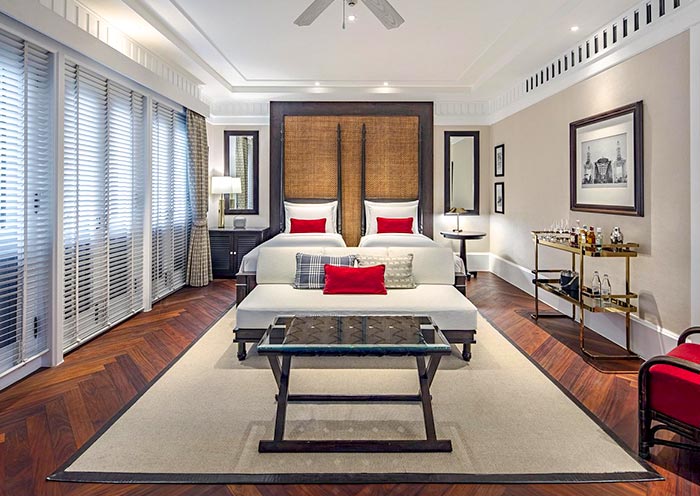
No matter whether you combine 2 or 3 countries, or visit all 4 countries in Southeast Asia, there are many different hotel styles and types to choose from. Travelers typically spend 7-9 nights in Vietnam, 6-9 nights in Thailand, and 2-3 nights each in Cambodia and Laos.
To cater to diverse traveler preferences and budgets, we offer a curated selection of accommodations. Our options include luxurious 5-star hotels, comfortable 4-star options, and economical 3-star establishments. All our selected hotels are conveniently located near city centers or popular tourist spots.
Find your perfect hotel for a great Southeast Asian experience! Our knowledgeable travel experts can provide you with various pricing options based on different hotels. Whether you seek a luxurious stay or have specific preferences, our experts will assist you in choosing the best option that suits your needs.
Photo Gallery for This Itinerary
Latest Southeast Asia Tours Reviews from Our Customers

Jan Woolley
USA
Date of Experience: Apr 26, 2024
Tour Customized by: Tony
You May be Interested in This Tour: Customized Tour

Emma
Singapore
Destination(s): Other
Date of Experience: Sep 14, 2023
Tour Customized by: Owen
You May be Interested in This Tour: Customized Tour

Arizona
Australia
Destination(s): Other
Date of Experience: Sep 04, 2023
Tour Customized by: Teresa
You May be Interested in This Tour: Customized Tour
Price: request
(Based on a private tour for two people. Price varies depending on program, travel date, number of people.)
Free Enquiry! You don’t need to pay for the reservation.
- United States (+1)
- Australia (+61)
- Singapore (+65)
- Malaysia (+60)
- Philippines (+63)
- Canada (+1)
- Italy (+39)
- Indonesia (+62)
- United Kingdom (+44)
- Spain (+34)
- Mexico (+52)
- Hong Kong (+852)
- Thailand (+66)
- United Arab Emirates (+971)
- New Zealand (+64)
- South Africa (+27)
- Germany (+49)
- Brazil (+55)
- India (+91)
- France (+33)
- Vietnam (+84)
- The Netherlands (+31)
- Saudi Arabia (+966)
- Ireland (+353)
- Argentina (+54)
- Switzerland (+41)
- Romania (+40)
- Pakistan (+92)
- Japan (+81)
- Portugal (+351)
- Bangladesh (+880)
- South Korea (+82)
- Puerto Rico (+1)
- Türkiye (+90)
- China (+86)
- Belgium (+32)
- Qatar (+974)
- Greece (+30)
- Taiwan (+886)
- Austria (+43)
- Poland (+48)
- Israel (+972)
- Chile (+56)
- Sri Lanka (+94)
- Nigeria (+234)
- Peru (+51)
- Colombia (+57)
- Hungary (+36)
- Nepal (+977)
- Denmark (+45)
- Bulgaria (+359)
- Norway (+47)
- Slovenia (+383)
- Sweden (+46)
- Kuwait (+965)
- Costa Rica (+506)
- Ecuador (+593)
- Venezuela (+58)
- Malta (+356)
- Croatia (+385)
- Tunisia (+216)
- Czechia (+420)
- Mongolia (+976)
- Bahrain (+973)
- Mauritius (+230)
- Papua New Guinea (+675)
- Cambodia (+855)
- Dominican Republic (+1)
- Luxembourg (+352)
- Finland (+358)
- Guatemala (+502)
- Myanmar (+95)
- Maldives (+960)
- Slovakia (+421)
- Laos (+856)
- Serbia (+381)
- Brunei (+673)
- Oman (+968)
- Macao (+853)
- Panama (+507)
- Morocco (+212)
- Jordan (+962)
- Georgia (+995)
- Fiji (+679)
- Bolivia (+591)
- Lithuania (+370)
- Bahamas (+1)
- Cyprus (+357)
- Latvia (+371)
- Bhutan (+975)
- Iraq (+964)
- Iran (+98)
- Kenya (+254)
- Jamaica (+1)
- Zimbabwe (+263)
- Azerbaijan (+994)
- Uruguay (+598)
- Estonia (+372)
- Andorra (+376)
- Cameroon (+237)
- Ghana (+233)
- Kazakhstan (+7)
- Nicaragua (+505)
- Egypt (+20)
- Russia (+7)
- Albania (+355)
- Réunion (+262)
- Montenegro (+382)
- Algeria (+213)
- Afghanistan (+93)
- Martinique (+596)
- Uganda (+256)
- Honduras (+504)
- North Macedonia (+389)
- Trinidad and Tobago (+1)
- Suriname (+597)
- Antigua and Barbuda (+1)
- Zambia (+260)
- Ukraine (+380)
- Armenia (+374)
- Barbados (+1)
- Belarus (+375)
- Palestine (+970)
- Lesotho (+266)
- Moldova (+373)
- Ethiopia (+251)
- French Polynesia (+689)
- Gambia (+220)
- Guam (+1)
- Gibraltar (+350)
- Isle of Man (+44)
- New Caledonia (+687)
- El Salvador (+503)
- Comoros (+269)
- Seychelles (+248)
- Chad (+235)
- Samoa (+685)
- Cook Islands (+682)
- Palau (+680)
- Paraguay (+595)
- DR Congo (+243)
- Solomon Islands (+677)
